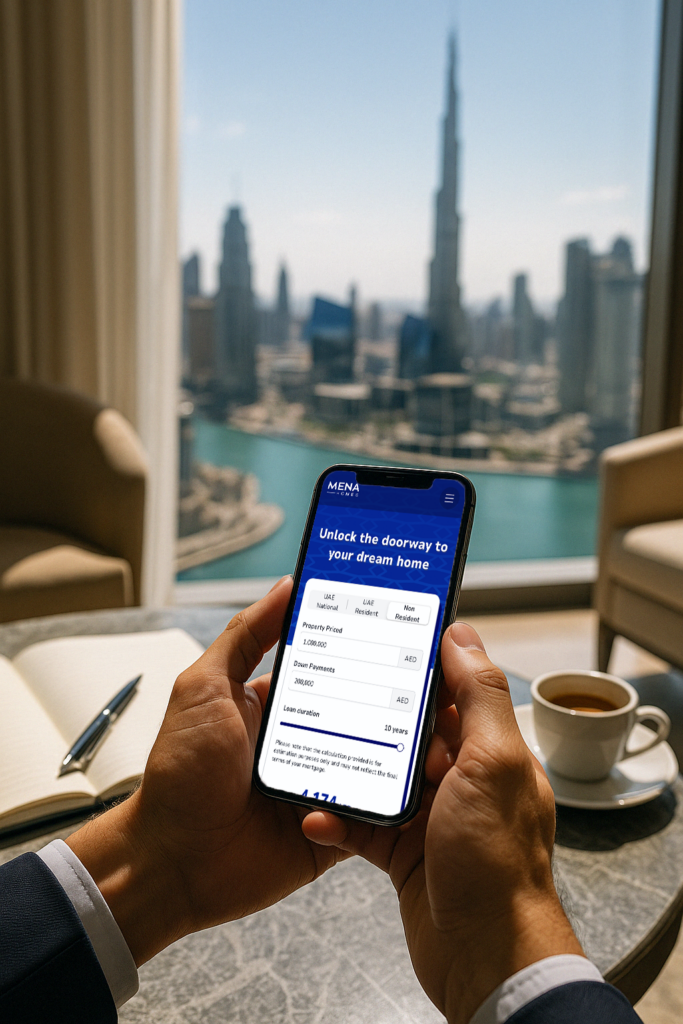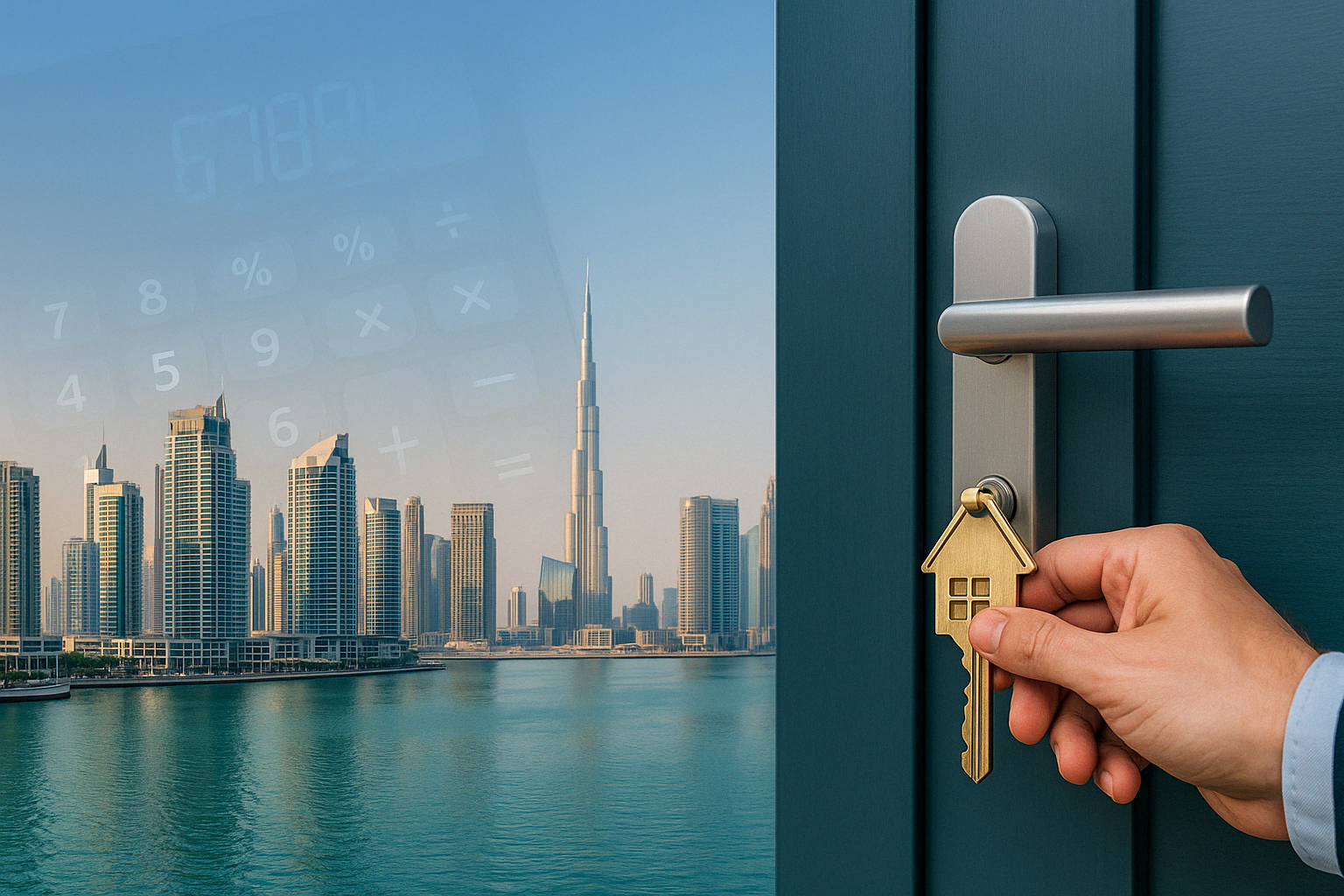Picture yourself turning the key to a home that’s truly yours, no endless rent hikes, no uncertainty about hidden fees. That’s the freedom Mena Homes’ Mortgage Calculator brings to the table.
In just a few clicks, you’ll have a clear view of potential monthly payments and overall costs, tailored to the UAE’s unique market. No matter if you’re a first-time buyer or a seasoned property investor, get ready to cut through the noise and see exactly what’s possible for your budget.
What Is a Mortgage Calculator and How Does It Work?
A mortgage calculator is essentially a digital budgeting tool for anyone contemplating a home purchase. It does the number crunching on your behalf to give you an idea of how much your monthly installments could be.
Plugging in the property price, down payment, interest rate, and loan tenure reveals what your monthly mortgage loan costs might look like and how much interest you could pay overall.
In practical terms, when you enter a property price of AED 1,000,000 with a 15% down payment, you’ll see right away how that figure translates into monthly dues over, say, a 10-year or 20-year mortgage.
Why Use the Mena Homes Mortgage Calculator?
The Mena Homes Mortgage Calculator is specifically designed for the UAE market, which means it accounts for local mortgage regulations that can differ for UAE nationals, residents, and non-residents..
You only need the property price, your intended down payment, the interest rate you’re offered, and how long you want to repay the loan. Hit calculate, and you’ll get an approximation of your monthly costs.
It’s also useful for comparing financing options across various local banks. If one institution offers you a 4% interest rate over 15 years, and another quotes 4.2% over 20 years, you can easily input each scenario to see which suits your budget.
Secure your dream home with the right mortgage – start comparing rates now!
Step-by-Step Guide to Using the Mortgage Calculator

1. Personalize Your Home Loan Details
Start by entering details that accurately reflect your unique financial situation. Think about the property price you’re aiming for, the amount you can comfortably allocate for a down payment, and how long you want to spread out your mortgage.
If you’re unsure about any figure, it’s often useful to overestimate your interest rate or set a slightly shorter loan term, so you have a buffer for unexpected costs.
2. Interpret Your Monthly Payments and Overall Cost
After inputting your data, the calculator displays an estimated monthly mortgage payment. This figure gives you a snapshot of how the principal (the amount you borrowed) and the interest (the cost of borrowing) are divided over the life of the loan.
You’ll also get a clearer picture of the total amount of interest you could pay over the full term. Use these insights to decide if you’d like to shorten the term (and pay less interest overall) or if you prefer lower monthly obligations by extending it.
Find out how much you can borrow—try our mortgage calculator now.
3. Compare Different Scenarios to Find Your Best Fit
No two homeowners share the exact same financial goals. That’s why it’s important to experiment with different combinations of down payments, home loan durations, and interest rates.
If you have some flexibility in your budget, for instance, try increasing your down payment to see how it affects your monthly payments and total interest.
Alternatively, compare a 15-year home loan against a 20-year loan to determine which balances immediate affordability with long-term savings. Adjusting these variables takes only seconds in the calculator, but it can reveal significant differences in how your mortgage evolves over time.
Key Factors That Influence Mortgage Payments in the UAE
Loan Amount and Its Impact
For properties in Dubai, a mortgage usually covers up to 85% of a property’s value for UAE nationals buying their first home (if priced at AED 5 million or less), while non-residents typically qualify for up to 50%, according to CBUAE mortgage loans regulations.
In practice, that means a UAE national shopping for a home priced at AED 3 million could finance up to AED 2.55 million, leaving AED 450,000 as a down payment
Non-residents looking at the same price point would need closer to AED 1.2 million down. The higher your home loan amount, the bigger your monthly installment, so it’s important to settle on a figure that aligns with your long-term budget.
Interest Rates: Fixed vs. Variable
Rates in the UAE can swing between 3% and 7%, and the choice between fixed and variable affects what you pay each month.
A three- or five-year fixed rate gives you a predictable monthly outlay, which can be a lifesaver if you’re worried about market fluctuations.
On the flip side, a variable rate might start lower but can climb over time. Even a 0.5% difference in interest can add up to tens of thousands of dirhams over the life of a loan.

Loan Tenure and Repayment Structure
Most UAE mortgages range from 5 to 25 years, but 25 is often the cap if you’re under 40. A shorter term means heftier monthly payments but less total interest.
Stretching to 20 or 25 years lowers your monthly cost yet increases the overall sum you’ll pay by the end. If you’re in it for the long haul—say 10 years or more—opting for a longer term can help with monthly budgeting, especially if you plan to rent out your property later or eventually sell it for a profit.
Down Payment Requirements in the UAE
The magic number for most residents is 20%, but a handful of lenders might stretch to 85% financing if you have a strong salary, zero existing loans, and stable employment history.
Non-residents, on the other hand, generally cap out at 50% financing, which means a 50% down payment. Either way, UAE banks want to see consistent income—often at least AED 25,000 per month if you’re applying from abroad—and some will also check your bank statements for a specific minimum balance.
Comparing Mortgage Options: How to Find the Best Home Loan
The best deal often comes down to how each financing method aligns with your cash flow and long-term plans.
Bank Mortgage Rates vs. Developer Financing
Most expatriates start by comparing bank mortgages, since local banks in the UAE have well-established processes for both residents and non-residents.
Developer financing can be an alternative route—some new-build projects, for example, let you pay in installments directly to the developer. This can sidestep certain bank fees, but you might pay higher rates in the long run or face more rigid payment schedules. It’s wise to line up both offers side by side and run the numbers through Mena Homes mortgage calculator for a clear comparison.
Understanding Hidden Fees and Costs
Expect to budget for:
- Valuation Fees: Banks typically order an official valuation of the property, charging between AED 2,500 and AED 3,000.
- Arrangement/Processing Fees: Often 1% of the loan amount (capped at a certain figure), though this varies by bank.
Life/Property Insurance: Policies can be mandatory, especially if you’re taking out a large mortgage.
Best Practices for Securing a Low-Interest Mortgage
A rock-solid credit score and stable proof of income are the first steps. If you’re a salary-based applicant, some UAE banks will take your first paycheck in the Emirates as enough proof—especially if your salary tops AED 40,000.
Self-employed individuals may need two years of audited financials or at least six months of consistent turnover in a business account. Shopping around is important, because one bank’s “special offer” might pale next to another bank’s standard rate once fees are factored in.
Common Mortgage Questions Answered
1. Is it possible to pay off my mortgage early without penalties?
Many UAE lenders allow early settlements or partial overpayments, but fees can apply. The fee is capped at a maximum of 1% of the outstanding balance or AED 10,000, whichever is less. Always check the specific terms in your mortgage agreement before making additional payments.
2. Can I switch to another bank if I find a better rate later?
Yes, refinancing or transferring your loan to a different bank is a viable option in the UAE. This process often involves new valuation fees and administrative charges, so it’s wise to compare the total costs of a transfer against the long-term savings from the reduced interest rate.
3. Do I need to have worked in the UAE for a certain period before applying?
Most lenders prefer at least three to six months of local employment history if you’re a resident, but there are exceptions. Certain banks will approve a mortgage once you receive your first salary in a UAE bank account—especially if you work for a reputable employer and have a higher-than-average income. Self-employed applicants generally need to show a longer history of stable turnover.
4. What if I plan to move out of the UAE before my mortgage is fully paid?
You can continue paying off the loan from abroad as long as your bank allows international transfers and you keep up with monthly installments. Alternatively, you could sell the property or rent it out to cover the mortgage payments. Check your lender’s policy on overseas payments to avoid any surprises.
5. Are there currency considerations if my income is in a different country?
UAE mortgages are typically disbursed in dirhams (AED). If your income is in another currency, fluctuations in exchange rates can affect the net amount you pay each month. Some expat buyers open a local bank account to stabilize monthly mortgage loan payments and minimize the impact of currency swings.
6. Can I refinance my loan if property values rise?
Yes. Many homeowners take advantage of rising property values through an “equity release,” which lets you borrow against the increased value of your home without selling it. This can free up funds for renovations, a new investment property, or other large expenses. Keep in mind, though, that banks require updated valuations and may have stricter requirements for non-residents.
Get Started With Mena Homes’ Mortgage Calculator Today
Ready to crunch the numbers? Head over to Mena Homes’ Mortgage Calculator and estimate your monthly payments in seconds. Experiment with different down payments, loan terms, and interest rates, so you can pinpoint a mortgage plan that truly fits your lifestyle.
And if you need additional guidance, our real estate financing experts are just a call or click away. Let’s transform your homeownership goals into a reality—starting right here, right now.









